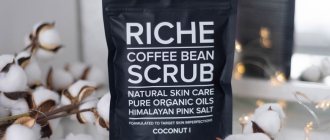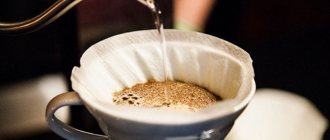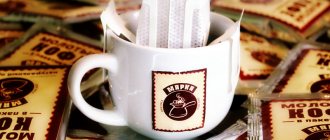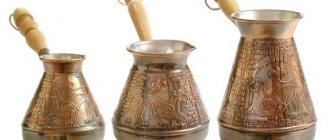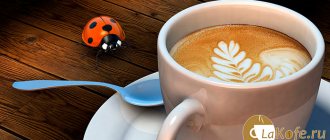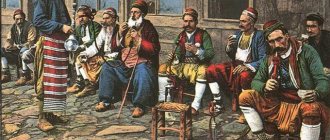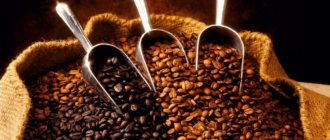Americans' passion for filter coffee is well known. Europe prefers espresso, the heart of the East is forever given to Turkish coffee. But since 2010, the whole world has been united by the fashion for a new way of brewing coffee - pour over. The special funnel (dripper) necessary for preparing the drink is also called.
The essence of the method is that a funnel, shaped like a cup, but with one or more holes at the bottom, is placed on a vessel into which the coffee will flow. A filter is placed in the dripper, ground coffee is poured into it and boiling water is poured over it. However, the process of preparing the drink has so many nuances that coffee lovers around the world enthusiastically argue about its duration, grinding, and the proportions of ground coffee and water.
Brewing coffee using a pour over
History of the pour over
Pour over translated from English means “pour from above.” The method of pouring boiling water over ground coffee has been known for a long time. Drip coffee makers have been used since the 19th century. And in 1908, a device similar to a modern pour-over appeared. According to some sources, it was invented by a German housewife in 1908; according to others, the device was invented in Japan.
Ruth Brown, author of a book about coffee, claims that in the American outback, funnels resembling pour-overs were used back in the second half of the 20th century. But the real fashion for pour-overs arose only at the beginning of this century, when the Japanese company Hario (translated from Japanese as “King of Glass”) began producing them.
Although accessories for pour over are produced by several other well-known companies (Bodum, Bonavita, Kalita), the word “hario” has become a household word, and some coffee lovers only call both the method of making coffee and the dripper funnel that way.
The marketing campaign carried out was truly brilliant. The Japanese had a surprise in store for each group of coffee connoisseurs:
- for lovers of all things natural – an opportunity to try a drink with the natural taste and aroma of grains. Coffee in a pour over receives the maximum amount of essential oils, and the ground beans cannot be burned, as when brewing in a Turk or a coffee machine;
- fans of Turkish or French press coffee - the drink is just as strong, but cleaner and more aromatic;
- for aesthetes - a ceremony comparable in beauty to a tea room. The process of making coffee using a pour-over is even called a “coffee ceremony”;
- for experimenters - a recipe where the slightest deviation from the dosage or rules entails a change in the taste of the drink.
Chemex
This is generally a manual drip coffee maker in its purest form; it is a vessel like a large laboratory flask and a filter. In fact, in the original this is a flask, and the name comes from here (chemex, derived from “chemistry”) - the method was invented by the chemist Peter Schlubom in his laboratory. That is, naturally, an ordinary drip coffee maker, only you need to pour hot water from the kettle yourself.
To achieve a more convincing extraction, it is usually customary to preheat the flask with hot water. Especially the narrowing point, at the level of which the coffee will be located during brewing. To avoid getting burned, there is an elegant wooden ring around this narrow neck, which you can use to hold this Chemex while brewing. In addition to warming up, water is poured in portions (according to the “pour and wait” principle, an analogue of pre-wetting in terms of coffee machines; by the way, this function is implemented in the Redmond SkyCoffee RCM-M1509S coffee maker) and water the entire area of coffee, and not just in the center, as in cheap drip coffee machines. coffee makers. All this allows you to achieve a slightly fuller taste than the latter.
Simply put, a Chemex is a specially shaped vessel plus a filter for preparing filter coffee manually. The manual mode allows you to control the process a little better than an automatic drip coffee maker, due to which the coffee turns out to be one iota tastier.
It is worth noting that Chemex is actually a brand. Original American Chemex costs some inadequate money in Russia (from 5,000 rubles, a little cheaper on Aliexpress), non-original analogues cost, like God, around 1,000 rubles. Moreover, this is not only a flask, but with a reusable filter. Although among true admirers of the “third wave” the use of reusable ones is considered trash.
Chemex coffee turns out weaker than the average Americano. Even the color is noticeable:
But at the same time, the taste is more or less full, the shades are felt, and for lovers of light coffee in large mugs, this method can, in principle, be recommended. It’s kind of like honest filtered coffee, but it’s difficult to get a distinctly better taste from the same beans than in a normal drip coffee maker.
Accessories for pour over
To make coffee using the pour-over method, you will need:
- pour-over funnel for brewing coffee;
- kettle-hario for hot water;
- funnel filters;
- glass jug or other vessel for ready-made coffee;
- clock (stopwatch);
- electronic scales with a flat surface.
Selecting a pour-over funnel
Classic pour-over funnel – Hario V60. Outwardly, it resembles a coffee cup with a handle and one hole in the bottom. The name V60 comes from the fact that the funnel is V-shaped and the walls are inclined at an angle of 60° to the bottom plane. On the inside of the walls there are convex ribs.
Hario V60 cross-section
Hario produces pourovers in 3 sizes:
- 01 – for brewing 1–2 cups of coffee;
- 02 – up to 4 cups;
- 03 – up to 6 cups.
There are pour-overs made of ceramics, glass and plastic on sale. The longer the funnel retains heat, the better. Therefore, ceramic pourovers are the most popular.
Glass models have low thermal conductivity and look very impressive: through their walls it is interesting to observe the movement of liquid. Plastic funnels are the cheapest. They are made from food-grade plastic that is odorless. Plastic pourovers are convenient to purchase for the garden: they are not as fragile as ceramic and glass ones.
Selecting filters for pourover
For Hario they produce:
- disposable paper filters of sizes 01, 02 and 03. Before use, they must be wetted so that the taste of the paper is not transferred to the drink;
- fabric (nylon) filters – reusable, mounted on a special holder;
- metal filters are reusable.
Choosing a kettle for hot water
To make coffee using a pour-over, you need a special kettle-hario: metal, with a long curved spout, fixed just above the bottom. There are both electric models and kettles designed for heating on the stove.
Pour over kettle
Since the kettle must be kept suspended for several minutes, its handle must be covered with thermal insulation material. If there is no special teapot, sometimes a regular teapot is used, but it is less convenient.
Choosing a vessel for ready-made coffee
The pourover can be installed over any ceramic or glass container, even over an ordinary cup, the main thing is that its walls retain heat for as long as possible. But the best option is a glass jug with a spout and measuring marks on the side (serving kettle): through its walls it is convenient to monitor the amount of finished coffee.
Siphon
The siphon is straight out of a history textbook. It was invented and used a little in Europe before the classic lever and electric espresso machines were developed and perfected. Speaking, again, in terms of classical options, a siphon is a geyser coffee maker without a middle flask, in which a coffee tablet is formed.
As in a geyser, the water in the lower bowl is heated (with an alcohol stove or a gas burner, of course, everything is hardcore), then it rises using the geyser method into the upper bowl. This is where the ground coffee is waiting for him, and where it is brewed. The entire structure cools down and the brewed coffee flows back into the lower flask in the same way.
I personally don’t like the siphon because due to the practically boiling (and it is extremely difficult to detect the moment of overheating) of the water in the lower flask, the final drink takes on a pronounced shade of boiled water. The strength of coffee from a siphon is comparable to a Chemex, maybe a little weaker. But subtle notes such as sour shades appear minimally, everything is neutralized by the high wateriness of overheated water.
By the way, “kosher” siphons are also produced by the company Hario, the estimated price is around 3,000 rubles with an extract from abroad; there are alternatives on Aliexpress that are half the price. In Russia, prices for siphons are depressing...
Selection of coffee for pour over
Since the drink contains the maximum amount of essential oils compared to other brewing methods, the choice of coffee for pour over is of great importance. Baristas recommend giving preference to freshly roasted single-origin Arabica beans. Arabica blends are also suitable, but blends with even a small amount of Robusta are not suitable: the drink will be bitter.
The roast should be no darker than medium (Viennese), but preferably lighter, grinding should be medium or coarse. When using a Hario paper filter, a slightly finer than medium grind (but not fine) is acceptable. The finer the grind, the fuller the drink will be. But particles that are too small clog the filter pores. In a drink made from coarsely ground coffee, the sourness is more clearly felt.
Water mineralization should be in the range of 70–200 mg/l (optimally 150 mg/l). Chlorinated tap water significantly worsens the taste of the drink.
Cold Brew or cold extraction method
This is actually something strange. We decided that it would be cool to brew coffee not with hot water, but with cold water. The thesis, in principle, has a right to exist - if it is overheated, the coffee will burn out and may begin to taste bitter, but you need to know when to stop, 60-80 degrees is enough to avoid burnout.
It is claimed that coffee brewed using the cold brew method contains fewer harmful substances, namely ketones, esters and amides. But the main thing is that it turns out less sour; in this sense, the cold method differs from other alternative brewing methods.
Since no extraction actually occurs when using cold water, the logical solution was to increase the contact time between water and coffee, that is, either a) increase the brewing time to 12 hours (I’m not kidding, but they usually set it to 7-8), or b ) lengthen all tracts, increase the volume of coffee (up to half a kilo per brew), increase the brewing vessel itself. In the second case, you get things like the one in the photo on the right. This is, of course, a commercial option, not for home use. In the commercial case, 50 or more liters are brewed per batch, then bottled and cooled in refrigerators.
And for the first option, when we “brew” coffee for 12 hours, they sell these basins for home use called Platon Filtron. In Russia they are found only through intermediaries who resell goods from the American Amazon; in their homeland they cost about $40. By the way, you need to use 500 grams of coffee at a time:
How to make pour over coffee - instructions
Fans argue about the proportions of coffee for pour over. Manufacturers recommend a ratio of 1:10 (per 10 g of coffee - 100 ml of water). But this drink is too strong. European baristas prefer a ratio of 1:17 (about 6 g of coffee per 100 ml of water). Nicholas Cho, owner of a roasting company and former chairman of the Executive Council of the American Barista Guild, considers 1:14.4 (25 g of coffee per 360 ml of water) to be the best ratio.
Water for coffee should be heated to a temperature of +92 to +96 °C. If the kettle is not equipped with a thermometer, then you need to wait 1 minute from the moment of boiling (“white key”) and start brewing coffee.
Coffee recipe
Ingredients:
- freshly ground – coffee 12–20 grams;
- water – 200 ml of water.
Cooking technology
- Place the pour over over a jug or cup. If you have electronic scales, place the entire structure on them.
- Place the filter in the pour over. Pour clean hot water into it to wet the filter, heat the pour-over and jug.
- Pour out the water.
- If the filter is paper, make sure that it does not stick completely to the walls of the pourover, but only touches the ribs. Thanks to the gaps between the walls of the funnel and the filter, more essential oils are released during coffee extraction, making the drink especially aromatic.
- Pour coffee into the filter, level it, and make a small depression in the middle.
- Moisten the ground coffee with water in a 1:1 ratio (for 20 ml of coffee - 20 ml of water) so that it “blooms”, that is, releases air bubbles. You can gently stir a little, being careful not to damage the filter. Wait 30 seconds.
- Use a thin stream of water, making concentric circular movements (from the sides to the center), to water the grounds for 2–2.5 minutes. The liquid level in the pour-over should not be more than 2 cm above the surface of the grounds. You should not pour water onto the walls of the pour-over: then it will leak out too quickly and the coffee will turn out weak. If water does not seep out, it means the grind is too fine.
- Wait until all the coffee is in the jug, remove the pour-over and pour the drink into cups.
The recipe given is basic. You can experiment with types of coffee, grinding, and brewing duration. Some baristas believe that the taste of the drink will improve if the liquid that seeped into the jug while soaking the ground coffee is poured out.
There is no limit to perfection
You may be left with the feeling that you can make it even tastier. Then your perfect recipe needs a few finishing touches. If the coffee is too strong, add some water directly. Later in the recipe you can reduce the amount of coffee or add more water. Conversely, if the strength is not enough, take more coffee or add less water. The richness of flavor can be adjusted by the degree of grinding and brewing temperature. Select the grind so that the extraction time falls within the range of 2:30-3:00, and the mass of coffee after brewing does not look like plasticine, and there are no too large particles. If this mass looks uneven, then work on your infusion technique. The NEFT Coffee Roasters training center offers a course on alternative brewing, where our trainers will provide an in-depth theoretical basis and, in practice, help you achieve excellent technique.
Types of pour overs
Each company makes its own improvements to the design of the pourover. The most famous modifications of the dripper:
Kalita Wave (Kalita) is a pour-over produced by the company of the same name. It differs from the hario in that in its bottom there is not one large, but 3 small holes. Thanks to this, the coffee extraction occurs more evenly. On the walls of the gate there are not ribs, but horizontal gutters. The company produces pleated paper filters for its pour-over. According to experts, coffee in Kalita is more aromatic and tastier than in Hario. But filters for wicket cost 3 times more.
Kalita
The December Coffee Dripper is the invention of Nicholas Cho. There are 12 holes in the bottom of this dripper. Using the pourover's rotating base, you can open and close the holes, adjusting the flow rate.
The December Coffee Dripper
conclusions
In my retrograde opinion, alternative coffee brewers are beautiful utensils that can be used to make filter coffee, but filter coffee itself does not allow you to get a rich taste. This comes with a fair share of “philosophy,” marketing, and the aura of belonging to a fashion subculture. If desired and with some skill, approximately the same result can be achieved by the banal method of brewing in a cup. And by taking an ordinary Soviet kitchen funnel from the mezzanine, you can achieve a similar result.
